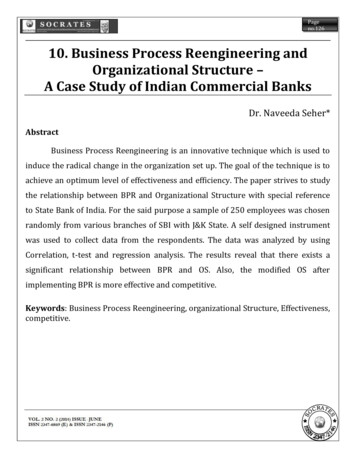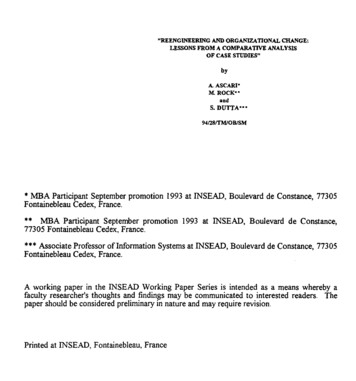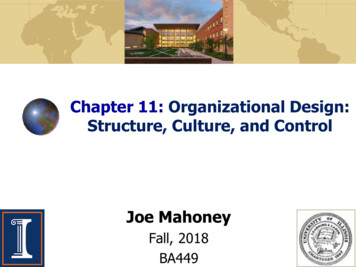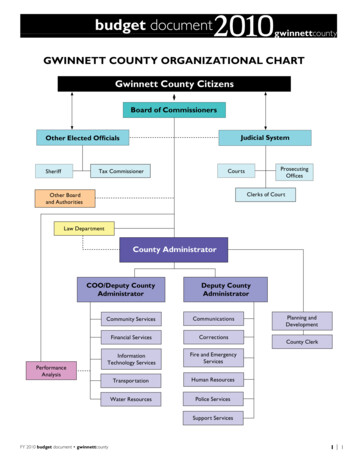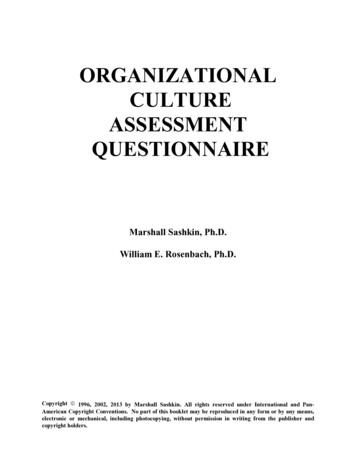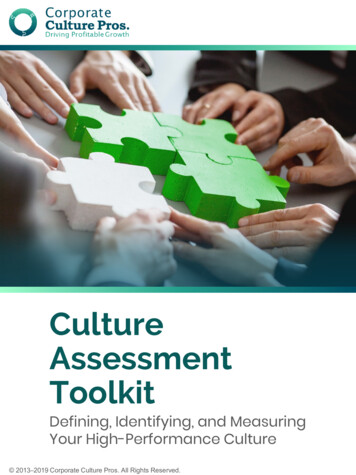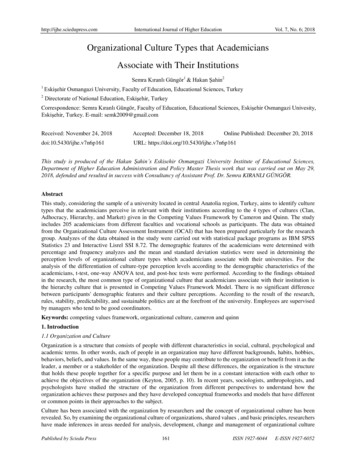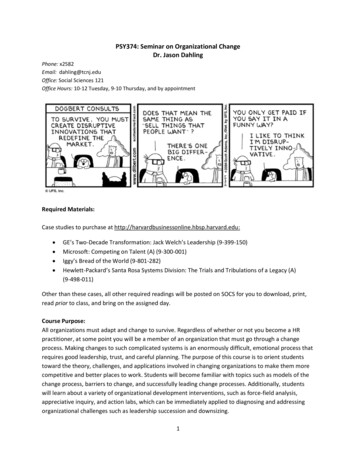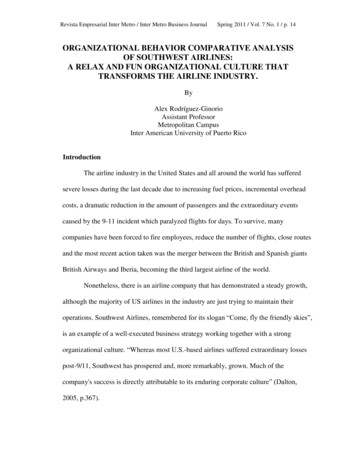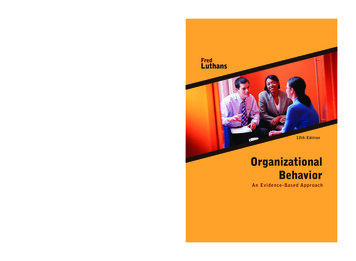
Transcription
on organizational behaviorFredLuthans12th EditionLuthanswww.mhhe.com/luthans12eISBN 978-0-07-353035-2MHID 0-07-353035-290000EAN9780073 530352www.mhhe.comOrganizationalBehaviorAn Evidence-Based ApproachMD DALIM #1059756 11/19/09 CYAN MAG YELO BLKAn Evidence-Based ApproachNew to the Twelfth Edition: The new subtitle “An Evidence-Based Approach” reaffirms the importance of the researchfoundation to the text. A new major section has been added to Chapter 1 that explains whythis evidence-based focus is so critical and what it entails. Because communication, decision making, and perception continue to be important to organizational behavior, Chapter 8, “Communication and Decision Making,” has been completely revised and the concept of perception has been added to Chapter 5, “Personality,Perception and Employee Attitudes.” Besides updating the evidence-base and providing new real-world examplesin each chapter, breakthroughs on important new topics suchas the following are included:12EOrganizational BehaviorThe Twelfth Edition of Organizational Behavior: An Evidence-Based Approach is ideal forthose who wish to take an up-to-date, evidence-based approach to organizational behavior andmanagement. This latest edition continues the tradition of narrowing the theory/research —effective application/practice gap by incorporating recent breakthrough research to provideand add to the evidence on the theories and techniques presented throughout the text.
Lut30352 FM i-xviii.qxd11/27/0912:03 PMPage iOrganizationalBehaviorAn Evidence-Based ApproachTwelfth EditionFred LuthansGeorge Holmes Distinguished Professorof Management, University of Nebraska
Lut30352 FM i-xviii.qxd12/5/099:56 AMPage iiORGANIZATIONAL BEHAVIOR: An Evidence-Based ApproachPublished by McGraw-Hill/Irwin, a business unit of The McGraw-Hill Companies, Inc., 1221Avenue of the Americas, New York, NY, 10020. Copyright 2011, 2008, 2005, 2002, 1998, 1995,1992, 1989, 1985, 1981, 1977, 1973 by The McGraw-Hill Companies, Inc. All rights reserved.No part of this publication may be reproduced or distributed in any form or by any means, orstored in a database or retrieval system, without the prior written consent of The McGraw-HillCompanies, Inc., including, but not limited to, in any network or other electronic storage ortransmission, or broadcast for distance learning.Some ancillaries, including electronic and print components, may not be available to customersoutside the United States.This book is printed on acid-free paper.1 2 3 4 5 6 7 8 9 0 WDQ/WDQ 1 0 9 8 7 6 5 4 3 2 1 0ISBN: 978-0-07-353035-2MHID: 0-07-353035-2Vice president and editor-in-chief: Brent GordonPublisher: Paul DuchamDirector of development: Ann TorbertManaging development editor: Laura Hurst SpellEditorial coordinator: Jane BeckVice president and director of marketing: Robin J. ZwettlerAssociate marketing manager: Jaime HaltemanVice president of editing, design and production: Sesha BolisettySenior project manager: Harvey YepSenior production supervisor: Debra R. SylvesterDesign coordinator: Joanne MennemeierMedia project manager: Suresh Babu, Hurix Systems Pvt. Ltd.Cover design: Joanne MennemeierCover image: Digital VisionTypeface: 10.5/12 Times RomanCompositor: Glyph InternationalPrinter: WorldcolorLibrary of Congress Cataloging-in-Publication DataLuthans, Fred.Organizational behavior : an evidence-based approach / Fred Luthans.—12th ed.p. cm.Includes index.ISBN-13: 978-0-07-353035-2 (alk. paper)ISBN-10: 0-07-353035-2 (alk. paper)1. Organizational behavior. I. Title.HD58.7.L88 2011658.4—dc222009041522www.mhhe.com
Lut30352 FM i-xviii.qxd11/27/0912:03 PMPage iiiForKay, Kristin, Brett, Kyle, and Paige
Lut30352 FM i-xviii.qxd11/27/0912:03 PMPage ivAbout the AuthorFred Luthansis the George Holmes Distinguished Professor of Management atthe University of Nebraska–Lincoln. He received his B.A., M.B.A., and Ph.D. from theUniversity of Iowa where he received the distinguished alumni award in 2002, and didpostdoctoral work at Columbia University. While serving as a Captain in the U.S. Army,he taught at the U.S. Military Academy at West Point. He has been at the University ofNebraska since 1967, his entire academic career, and won the distinguished teachingaward in 1986, the excellence in graduate education award in 2000, and in 2008 the highest award in the system for outstanding research. In 2003, he received an honorary doctorate from DePaul University. A prolific writer, he has published a number of majorbooks and about 200 articles in applied and academic journals. His book OrganizationalBehavior Modification, coauthored with Robert Kreitner, won the American Society ofPersonnel Administration award for outstanding contribution to human resource management, and another book entitled Real Managers is the result of a four-year researchstudy that observed managers in their natural settings. International Management, coauthored with the late Richard Hodgetts and Jonathon Doh, also published by McGraw-Hill,is in its seventh edition. He also has two recent books, The High Impact Leader (withBruce Avolio, McGraw-Hill, 2006) and Psychological Capital (with Carolyn Youssef andBruce Avolio, Oxford, 2007). The co-editor-in-chief of the Journal of World Business,Professor Luthans is also the editor for Organizational Dynamics and Journal of Leadership and Organizational Studies. He has been very active in the Academy of Management over the years and was elected a fellow in 1981. He is a former president ofthe National Academy in 1986 and, in 1997, received the Academy’s distinguished educator award. In 2000 he became an inaugural member of the Academy’s Hall of Famefor being one of the “Top Five” all-time published authors in the prestigious Academyjournals. Also active in the Decision Sciences Institute (DSI), he was elected a fellow in1987. Professor Luthans has a very extensive research program at the University ofNebraska. Most recently, he has developed positive organizational behavior, or POB(outlined in 2002 articles in the Academy of Management Executive and Journal ofOrganizational Behavior), and is conducting research on positive psychological capitaland, with close colleague Bruce Avolio, authentic leadership. He has been a visitingscholar at a number of universities in the United States and has lectured at universitiesand conducted workshops for managers in many countries around the world. In recentyears, he has been actively involved in Germany, China, Thailand, Singapore, Russia,Albania, and Macedonia. In addition, he has been on the executive committee of theannual Pan Pacific Conference since its beginning in 1984 and in 1995 was elected a fellow. This international research and experience is reflected in his approach to the fieldof organizational behavior. In addition, he is an active consultant and trainer to both private(such as Walmart and Ameritas Life Insurance, Inc.) and public-sector organizations.Since 1998 he has been a senior research scientist with the Gallup Organization. He isan avid golfer and University of Nebraska sports fan. He and Kay, his wife of 47 years,have four grown children and so far six adorable grandchildren.iv
Lut30352 FM i-xviii.qxd11/27/0912:03 PMPage vPrefaceHere is the twelfth edition. As I indicated in the last edition, I am still in what positivepsychologists call “flow.” I am so engrossed and passionate about my field of organizational behavior that time just flies. As I have said before, I take considerable pride in thesustainability of this text. It took me four years to write the first edition, and then abouta year to do each subsequent edition. Because of the rapidly expanding body of knowledge in organizational behavior, these revised editions through the years have becomeincreasingly challenging. However, I am still—actually even more than ever—in flow intrying to keep this first mainline organizational behavior text totally up-to-date with thevery latest and relevant theory building, basic and applied research, and best-practiceapplications. I decided with this edition to give special recognition of this scientific foundation by adding the subtitle—An Evidence-Based Approach.As is now emphasized in the introductory chapter, the time has come to help narrowthe theory/research—effective application/practice gap. This has been my mission fromthe beginning of this text and my now over 20-year editorship of the journalOrganizational Dynamics. As “hard evidence” for this theory/research base for this text,I can say unequivocally that no other organizational behavior text has close to the number of footnote references. For example, whereas a few texts may have up to 40 or even50 references for some chapters, the chapters of this text average more than twice thatamount. This latest edition continues the tradition by incorporating recent breakthroughresearch to provide and add to the evidence on the theories and techniques presentedthroughout.Before getting into the specific additions of this new edition, I would like to again pointout the distinguishing features that no other organizational behavior textbook can claim:1. I am convinced at this stage of development of the field of OB, we need a comprehensive theoretical framework to structure our introductory textbooks. Instead of apotpourri of chapters and topics, and maybe using an inductive (or should it be deductive?) sequencing, there is now the opportunity to have a sound conceptual frameworkto present our now credible (evidence-based) body of knowledge. I use the widelyrecognized, very comprehensive social cognitive theory to structure this text. I presentthe background and theory building of this framework in the introductory chapter andalso provide a specific model (Figure 1.5) that fits in all 14 chapters. Importantly, thelogic of this conceptual framework requires two chapters not found in other texts andthe rearrangement and combination of several others. For example, in the organizationalcontext part there is Chapter 4, “Reward Systems,” and in the cognitive processes part,Chapter 7, “Positive Organizational Behavior and Psychological Capital,” that no othertext contains.2. Besides having the only comprehensive theoretical framework for an introductory OBtext, a second unique feature is one or more OB Principles at the end of each chapter. Importantly, these principles are derived from meta-analytic research findings. Thereason for including meta-analytically derived principles is that the field of organizational behavior has matured to the point where there are not just isolated studies buta stream of research on a number of topics that now need to be systematically (quantitatively) summarized for students and practitioners. For example, Alex Stajkovic andI have completed a meta-analysis of the studies with which I have been most closelyassociated over the past 35 years, focusing on the positive effect that organizationalbehavior modification (O.B. Mod.) has on task performance. (This analysis is publishedv
Lut30352 FM i-xviii.qxdvi11/27/0912:03 PMPage viPrefacein the Academy of Management Journal; a follow-up research study conducted in thelargest credit card processing company in the world is in a subsequent issue of AMJ;another meta-analysis of all behavioral management studies with emphasis on the different types of interventions was published in Personnel Psychology; and mostrecently nonfinancial rewards were found to be as impactful on unit performance outcomes and employee retention over time as were financial rewards, published in theJournal of Applied Psychology with Suzanne Peterson). In addition, Alex and I published in Psychological Bulletin a meta-analysis (114 studies, 21,616 subjects) thatfound a very strong positive relationship between self-efficacy and task-related performance. These provide end-of-chapter evidence-based OB Principles.3. A third unique feature is an “Evidence-Based Consulting Practices” summary to openup each major part of the text. Specifically, in addition to my long academic appointment at the University of Nebraska, since 1998 I have been a senior research scientist with the Gallup Organization. Mostly known for the famous Gallup Poll, thisworld-class firm also has a widely known management consulting practice. Abouthalf of the “Fortune 50” are among Gallup’s recent clients. With my input, TimHodges, executive director of Gallup University, drew from Gallup’s tremendous survey research-base consisting of thousands of organizations and millions of peopleover the years. We provide Gallup’s evidence-based practices relevant to each majorpart of the text.4. The fourth unique feature reflects my continuing basic research program over theyears. Chapter 7 contains my most recent work on what I have termed “PositiveOrganizational Behavior” and “Psychological Capital” (or PsyCap). To meet theinclusion criteria (positive; theory and research based; valid measures; open todevelopment; and manage for performance improvement), for the first time the topics of optimism, hope, happiness/subjective well-being, resiliency, emotional intelligence, self-efficacy, and the overall core construct of psychological capital havebeen given chapter status. Because of my involvement in the emerging Positive Psychology movement through Gallup and my research on PsyCap and authentic leadership with colleagues in the University of Nebraska’s Leadership Institute, I feelthe time has come to incorporate this positive approach into the mainstream organizational behavior field.Besides these truly significant four unique features, there are a number of specificrevisions and additions to this edition. These include:1. The new subtitle “An Evidence-Based Approach” reaffirms the importance of theresearch foundation to the text. A new major section has been added to Chapter 1 thatexplains why this evidence-based focus is so critical and what it entails.2. Because communication, decision making, and perception continue to be important toorganizational behavior, in this edition there is a new Chapter 8, “Communication andDecision Making” and perception is added to Chapter 5, “Personality, Perception, andEmployee Attitudes.”3. To make room for the new chapter, the separate chapter on job design and goal settingis now incorporated into Chapter 6, “Motivational Needs, Processes, and Applications.”4. Besides updating the evidence-base and providing new real-world examples in eachchapter, breakthroughs on important new topics such as the following are included: Contextual impact of the recent financial crisis and stock market crash on organizational behavior
Lut30352 FM i-xviii.qxd11/27/0912:03 PMPage viiPreface vii Collins’ “Good to Great” expectationsManaging the global workforceGlobal mindsetDiversity management skillsGlass ceiling outside the United StatesCorporate social responsibility (CSR)Ethics of downsizing“Hollow” organization designModular organization designOrganization culture in an economic crisisIncentive/rewards analysis of the financial crisisCosts of obesityNeuroscience explanationsHealth-Relationships-Work (H-R-W) well-being modelIntentional component of psychological capital (PsyCap)Background on PsyCapPerformance impact and research summary of PsyCapPsyCap development model and research summaryEvidence-based happinessBroaden and Build Theory of positivityUse of FacebookGen X and Gen YStress from 24/7 technology and job loss threatStress levels around the worldBullying problem“Slacker teammate” problemFollowershipPositive and authentic leadership researchJust as real-world management can no longer afford to evolve slowly, neither canthe academic side of the field. With the uncertain, very turbulent environment mostorganizations face today, drastically new ideas, approaches, and techniques as represented above are needed both in the practice of management and in the way we studyand apply the field of organizational behavior. This revision mirrors these neededchanges.Social Cognitive Conceptual Framework. The book contains 14 chapters in four majorparts. Social cognitive theory explains organizational behavior in terms of both environmental, contextual events and internal cognitive factors, as well as the dynamics and outcomes of the organizational behavior itself. Thus, Part One provides the evidence-basedand organizational context for the study and application of organizational behavior. Theintroductory chapter provides the environmental perspective, historical background,methodology, theoretical framework, and specific social cognitive model for the field oforganizational behavior in general and specifically for this text. This is followed by anoverall environmental context chapter:
Lut30352 FM i-xviii.qxd11/27/0912:03 PMPage viiiviii PrefaceChapter 2, “Environmental Context: Globalization, Diversity, and Ethics (with majorsections on globalization, diversity, and a major ending section on the impact of ethicson “bottom-line” outcomes).After this broad environmental context is laid out in Chapter 2, there are two chaptersfor the organizational context of the social cognitive framework:Chapter 3, “Organizational Context: Design and Culture” (with special emphasisgiven to the learning organization and horizontal, hollow, modular, network, and virtual designs; best-practice cultures; and a major section on the culture clashes frommergers and acquisitions) andChapter 4, “Organizational Context: Reward Systems” (a unique chapter with special emphasis given to money as a reward, effectiveness of pay, forms of “new pay,”recognition systems, and benefits).The second part of the text recognizes the well-known micro-oriented cognitiveprocesses of the social cognitive framework plus unique topics such as the following:Chapter 5, “Personality, Perception, and Employee Attitudes” (with unique major sections on the role of heredity and the brain and emphasis given to “Big Five” personalitytraits, the Myers-Briggs personality indicator, the perceptual process, and organizational citizenship behavior);Chapter 6, “Motivational Needs, Processes, and Applications” (with major sectionson extrinsic versus intrinsic motives, procedural justice, attribution theory, job designand goal setting); andChapter 7, the most unique chapter, not only for this text, but any other, on “Positive Organizational Behavior and Psychological Capital.” In addition to the focus onthe unique POB psychological states of efficacy, optimism, hope, resiliency, and overall psychological capital, there are also major sections on emotion, multiple intelligences, and general mental abilities.Parts Three and Four are concerned with the dynamics and behavior management andleadership dimensions of organizational behavior in the social cognitive framework. PartThree contains, in addition to widely recognized topics, the following four chapters:Chapter 8, “Communication and Decision Making” with particular emphasis givento nonverbal and interpersonal communication and behavioral dimensions, styles, andtechniques of decision making.Chapter 9, “Stress and Conflict” (with material on stress and conflict from advancedtechnology and globalization, burnout, and work-family initiatives);Chapter 10, “Power and Politics” (with material on empowerment, trust, resourcedependency, and the dynamics of power and politics in the new environment); andChapter 11, “Groups and Teams” (with material on the punctuated equilibrium modelof groups, group/team effectiveness, role conflict and ambiguity, social loafing, crossfunctional teams, virtual teams, and cultural/global issues with the use of teams).The final Part Four gives an applied emphasis to the text. It focuses on how to manage and lead for high performance. These applied organizational behavior chaptersinclude the following:Chapter 12, “Behavioral Performance Management” (with material on the role ofsocial cognition, critical analysis of reinforcement theory, pay for performance, social
Lut30352 FM i-xviii.qxd11/27/0912:03 PMPage ixPreface ixrecognition, and the latest research on contingencies with type of organization andinterventions for O.B. Mod. effectiveness).Chapter 13, “Effective Leadership Processes” (with major sections on the historicalstudies, traditional and modern theories of leadership and the new “authentic leadership” being developed at the University of Nebraska’s Leadership Institute, and leadership across cultures and the GLOBE project).Chapter 14, “Great Leaders: An Evidence-Based Approach” (with major sectionson leading in the new environment, leadership styles, including the new positive,authentic style, the activities and skills of leadership, and leadership developmentprograms).Pedagogical Features. Besides the many unique features already described, there are alsoseveral strong pedagogical features that have characterized the text over the years. Toreflect and reinforce the applications orientation of the text, highlighted, currently relevant, boxed real-world OB in Action examples appear in each chapter. In this twelfthedition there are many new real-world examples drawn from BusinessWeek articles. Inaddition to these application boxes, the text also features experiential exercises at the endof each part. The exercises get participants involved in solving simulated problems orexperiencing firsthand organizational behavior issues. Also there are end-of-chapter Internetexercises to get students involved in online relevant resources and vehicles for discussion and critique.Besides the usual end-of-chapter short organizational behavior discussion cases, thereis also at least one Real Case at the end of each chapter. These cases are drawn fromrecent real-world events (excerpted from current BusinessWeek articles) and are intendedto enhance the relevancy and application of the theories and research results presentedin the chapter. These end-of-chapter real cases serve as both examples and discussionvehicles. It is suggested that students read them even if they are not discussed directlyin class. The intent is that they can serve as supplemental readings as well as discussion cases.This edition also contains learning objectives at the start of each chapter. These objectives should help students better focus and prepare for what follows in the chapter.Finally, the chapters have the usual end-of-chapter summaries and review and discussionquestions.Intended Audience. Despite the four unique features and very extensive updating (having anywhere from 5–30 or more new references per chapter) throughout, the purposeand intended audience of the book remain the same. As in the earlier editions, this edition is aimed at those who wish to take a totally up-to-date, evidence-based approachto organizational behavior and management. It does not assume the reader’s priorknowledge of either management or the behavioral sciences. Thus, the book can beused effectively in the first or only course in either four-year or two-year colleges. Itis aimed primarily at the required organizational behavior course, at the undergraduate level or in the M.B.A. program. I would like to especially acknowledge and thankcolleagues in countries around the world who have used previous editions of the bookand point out that the continued international perspective and coverage should makethis new edition relevant and attractive. Finally, the book should be helpful to practicingmanagers who want to understand and more effectively manage their most importantassets—their human resources.
Lut30352 FM i-xviii.qxdx11/27/0912:03 PMPage xPrefaceAcknowledgments. Every author owes a great deal to others, and I am no exception.First and foremost, I would like to acknowledge the help on this as well as many otherwriting projects over the years that I received from my deceased friend and colleague,Professor Richard M. Hodgetts of Florida International University. Next, I would liketo acknowledge the total support and standards of excellence provided by my friend andlongtime department chairman, Sang M. Lee and my former colleague now at the University of Washington, Bruce Avolio. Special thanks goes to Cathy Watson from theManagement Department staff who has been very helpful to me over the years. I cannever forget the education, encouragement, and scholarly values I received from Professors Henry H. Albers and the deceased Max S. Wortman when starting out in myacademic career. Over the years, I have been very lucky to have been associated withexcellent doctoral students. I would like to thank them all for teaching me as much asI have taught them. In particular, I would like to thank Don Baack, Steve Farner, andSuzanne Peterson who have helped on previous editions. I am also very grateful to thoseprofessors who used the previous editions of the book and gave me valuable feedbackfor making this revision. The reviewers for this edition are Charles B. Daniels, OldDominion University; Laura Finnerty Paul, Skidmore College; and James Harbin, TexasA&M University–Texarkana. Finally, as always, I am deeply appreciative and dedicateOrganizational Behavior, twelfth edition, to my wife and now grown children and theirfamilies, who have provided me with a loving, supportive relationship and climateneeded to complete this and other projects over the years.
Lut30352 FM i-xviii.qxd11/27/0912:03 PMPage xiContents in BriefPART ONEPART THREEEnvironmental and OrganizationalContext 1Dynamics of Organizational Behavior 2451Introduction to Organizational Behavior:An Evidence-Based Approach 52Environmental Context: Globalization,Diversity, and Ethics 313Organizational Context: Designand Culture 574Organizational Context: RewardSystems 88PART TWOCognitive Processes of OrganizationalBehavior 1238Communication and DecisionMaking 2479Stress and Conflict 27710 Power and Politics 31211 Groups and Teams 339PART FOURManaging and Leading for HighPerformance 37312 Behavioral PerformanceManagement 37813 Effective Leadership Processes 41314 Great Leaders: An Evidence-BasedApproach 4455Personality, Perception, and EmployeeAttitudes 1256Motivational Needs, Processes, andApplications 156Footnote References and SupplementalReadings 4827Positive Organizational Behavior andPsychological Capital 199References for Application Boxes andReal Cases 548INDEX 551xi
Lut30352 FM i-xviii.qxd11/27/0912:03 PMPage xiiContentsAbout the Author ivPreface vPART ONEENVIRONMENTAL ANDORGANIZATIONAL CONTEXT 1Evidence-Based Consulting Practices 1Chapter 1Introduction to Organizational Behavior:An Evidence-Based Approach 5Learning Objectives 5The Challenges Facing Management 6Undergoing a Paradigm Shift 8A New Perspective for Management 10Evidence-Based Management 12Historical Background: The Hawthorne Studies 13The Illumination Studies: A Serendipitous Discovery 13Subsequent Phases of the Hawthorne Studies 14Implications of the Hawthorne Studies 15Research Methodology to Determine ValidEvidence 16The Overall Scientific Perspective 16Starting with Theory 17The Use of Research Designs 18The Validity of Studies 19Defining Organizational Behavior 20Theoretical Foundation for OrganizationalBehavior 20Cognitive Framework 20Behavioristic Framework 21Social Cognitive Framework 22The Conceptual Framework for the Text 25Summary 25Ending with Meta-Analytic Research Findings 26Questions for Discussion and Review 27Internet Exercise: Nonjobs or Telecommuting 27Real Case: The Big Squeeze on Workers 28Organizational Behavior Case: How Is This StuffGoing to Help Me? 29Organizational Behavior Case: Too Nice to People 29xiiOrganizational Behavior Case: Conceptual Model:Dream or Reality? 30Chapter 2Environmental Context: Globalization,Diversity, and Ethics 31Learning Objectives 31Globalization 31Diversity in the Workplace 34Reasons for the Emergence of Diversity 35Developing the Multicultural Organization 38Individual Approaches to Managing Diversity 39Organizational Approaches to Managing Diversity 41Ethics and Ethical Behavior in Organizations 46The Impact of Ethics on “Bottom-Line” Outcomes 47Summary 49Ending with Meta-Analytic Research Findings 50Questions for Discussion and Review 52Internet Exercise: Ethical Issues in the Workplace 52Organizational Behavior Case: How Far-Reaching AreGlobalization and Technology? 52Organizational Behavior Case: I Want Out 53Real Case: Not Treating Everyone the Same 53Organizational Behavior Case: Changing with theTimes 54Real Case: The Ethics of Downsizing 55Chapter 3Organizational Context: Designand Culture 57Learning Objectives 57The Organizational Theory Foundation 58Historical Roots 58Modern Theoretical Foundation 58What Is Meant by a Learning Organization? 59Organizational Behavior in the LearningOrganization 60Learning Organizations in Action 61Modern Organization Designs 63Horizontal Organizations 64Contemporary Designs: Hollow and Modular 65Network Designs 66The Virtual Organization 68
Lut30352 FM i-xviii.qxd11/27/0912:03 PMPage xiiiContents xiiiThe Organizational Culture Context 71Definition and CharacteristicsUniformity of Culture 7371Exercise: Work-Related Organizational Behavior:Implications for the Course 118Exercise: Organizations 119Creating and Maintaining a Culture 74How Organizational Cultures Start 75Maintaining Cultures through Steps of Socialization 76Changing Organizational Culture 79Summary 83Ending with Meta-Analytic Research Findings 84Questions for Discussion and Review 84Internet Exercise: The Structure and Culture ofOrganizations 85Real Case: Web-Based Organizations 85Organizational Behavior Case: The OutdatedStructure 86Organizational Behavior Case: Keeping Things theSame 86Organizational Behavior Case: Out with the Old,In with the New 87Chapter 4Organizational Context: RewardSystems 88Learning Objectives 88Pay: The Dominant Organizational Reward 90The Theoretical Background on Money as a Reward 90Research on the Effectiveness of Pay 92Traditional Methods of Administ
12th Edition 9 780073 530352 9 0 0 0 0 www.mhhe.com ISBN 978-0-07-353035-2 MHID 0-07-353035-2 EAN The Twelfth Edition of Organizational Behavior: An Evidence-Based Approach is ideal for those who wish to take an up-to-date, evidence-based approach to
